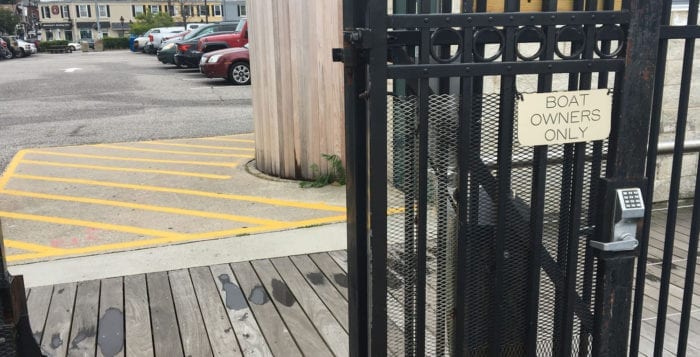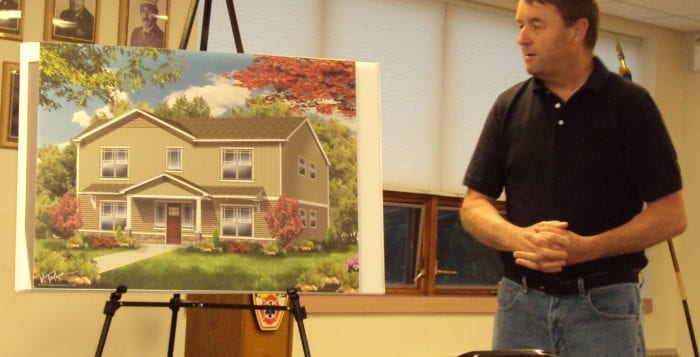By Daniel Dunaief
If homeowners could find insects in their home, confirm that they were termites and locate nests before the termites damaged a house, they’d save themselves numerous problems. The same holds true for cancer.
Using the latest molecular biology techniques, researchers at Cold Spring Harbor Laboratory including Associate Professor Alexander Krasnitz and Professor Michael Wigler have explored ways to detect cancer earlier.
Unlike other scientists, who have created tests that reveal the genetic probability of developing cancer, Krasnitz and Wigler developed a blood test to reveal the presence of a tumor that might be hard to spot. Such a test could be particularly valuable for cancers such as ovarian and pancreatic cancer, which can be inoperable by the time they present clinical symptoms.
Urging what Wigler described as a “call to arms,” Krasnitz said they created a blood test, called copy number variation, that they hope will be economically feasible. In copy number variation, sections of genes are repeated. While healthy cells have copy number variation, cancer cells use them like a Jack Nicholson mantra in “The Shining,” where the repetition of “all work and no play makes Jack a dull boy” becomes a calling card for a killing spree.
In cancer, chromosomes or chromosome arms are duplicated or deleted. Sometimes, a narrow region of the genome undergoes amplification, creating multiple copies of the region. Other times, a region of the genome may be lost. Genome-wide copy number variation is a hallmark of cancer. Copy number variation occurs often amid the disruption of DNA repair mechanisms and the breakdown in the way DNA separates into daughter cells during division.
In a recent article in Trends in Molecular Medicine, Krasnitz, Jude Kendall, Joan Alexander, Dan Levy and Wigler — all scientists at CSHL — suggest the potential for single-cell genomic analysis that searches for the presence of copy number variations could raise the alert level for cancer, signaling the need to search more closely for developing tumors.
In most massive cancers in the population, including breast, ovarian and prostate cancer, copy number variation is “ubiquitous,” Krasnitz said. Screening for these changes could provide “evidence for the presence of something abnormal,” which can be validated through other tests, Krasnitz said.
Copy number variation, on its own, is not sufficient to detect cancer, Krasnitz said. Researchers need evidence of similar abnormal copy number profiles in multiple cells. For this test to have clinical relevance, it would need to minimize false positives, which could create alarm and lead to future tests that might not be warranted, while also avoiding false negatives, which would miss the presence of cancer.
The main sources of false positives could come from copy number variation that’s already in cells in the blood that randomly look like a tumor. Cells with partially degraded DNA can have high copy number variation, which the researchers have observed. These profiles, however, arise from random processes and typically look different from each other. Cells from a cancer clone, however, have similar copy number profile.
Cancers with low copy number variation were a minority among the 11 cancers the scientists studied and include a type of colorectal cancer called microsatellite-unstable. If these CSHL researchers developed a preclinical test, they would look for additional ways to detect such cancers.
While numerous technological innovations required for the test exist, including copy number profiling of single cells and methods to enrich specimens from blood for suspected tumors, Krasnitz explained that considerable work remains before its clinical use, including establishing tumor cell counts in the blood of early patients, making single-cell profiling cheaper and finding optimal ways to identify the tissue of origin.
They are planning to study newly diagnosed patients to observe the presence of circulating cells from tumors. Once the scientists prove that the test has some predictive value, they need to ensure that it is economical and that they can follow up with patients to find tumors.
At this point, it’s unclear what the presence of copy number variation might reveal about the type of tumor, which could be a slowly growing or an aggressive type. Additionally, an abnormal indication from this type of analysis wouldn’t reveal anything about the type of cancer. Further tests, including on RNA, would help direct doctors to a specific organ or system.
Apart from his work with Wigler, Krasnitz also has numerous collaborations, including one with CSHL Cancer Center Director David Tuveson.
In his work with Tuveson, Krasnitz is ensuring that the organoid models Tuveson’s lab creates, which are living replicas of tumors taken from patients, faithfully reflect the genetic make up of the tumors. That, Tuveson said, is a significant undertaking because it can validate the organoid model for exploring the biology of tumors.
“This is a deliverable that many people are waiting for,” Tuveson said. The researchers want to make sure “what we grew is what the patient had in the first place.” So far, Tuveson said, the data looks good and the scientists don’t have any examples of the genetics of the organoids differing from that of the tumor.
Krasnitz also attempts to predict an organoid’s response to drugs that haven’t been tested yet based on the organoid’s reaction to other drugs. Tuveson reached out to Krasnitz to work with his group. He said Krasnitz is “a major player” and is “very skilled” in the type of analysis of big data his group generates through the genome, the transcriptome and drug screens. “He’s able to look at those three types of information and make sense of it,” Tuveson said.
Krasnitz is grateful for the support of the Simons Foundation, the National Institutes of Health and the Breast Cancer Research Foundation for his work with Wigler. The most recent article with Wigler is an “invitation for the [research] community to join in the effort,” Krasnitz said. “We want collaborators and more competition in this area.”












 Aaaah, summer’s here and we know it by the smells in the air. Tantalizing aromas of steak, sausage, chicken, burgers and dogs. After dinner it’s marshmallows (sometimes with graham crackers and chocolate). I don’t know anyone who doesn’t love it (including our pets). As gratifying as it is to have friends and family over, we have to be careful of our “unofficial tasters” hanging around the barbecue.
Aaaah, summer’s here and we know it by the smells in the air. Tantalizing aromas of steak, sausage, chicken, burgers and dogs. After dinner it’s marshmallows (sometimes with graham crackers and chocolate). I don’t know anyone who doesn’t love it (including our pets). As gratifying as it is to have friends and family over, we have to be careful of our “unofficial tasters” hanging around the barbecue.





